GMC SONOMA 2003 Owner's Manual
Manufacturer: GMC, Model Year: 2003, Model line: SONOMA, Model: GMC SONOMA 2003Pages: 424, PDF Size: 2.45 MB
Page 281 of 424
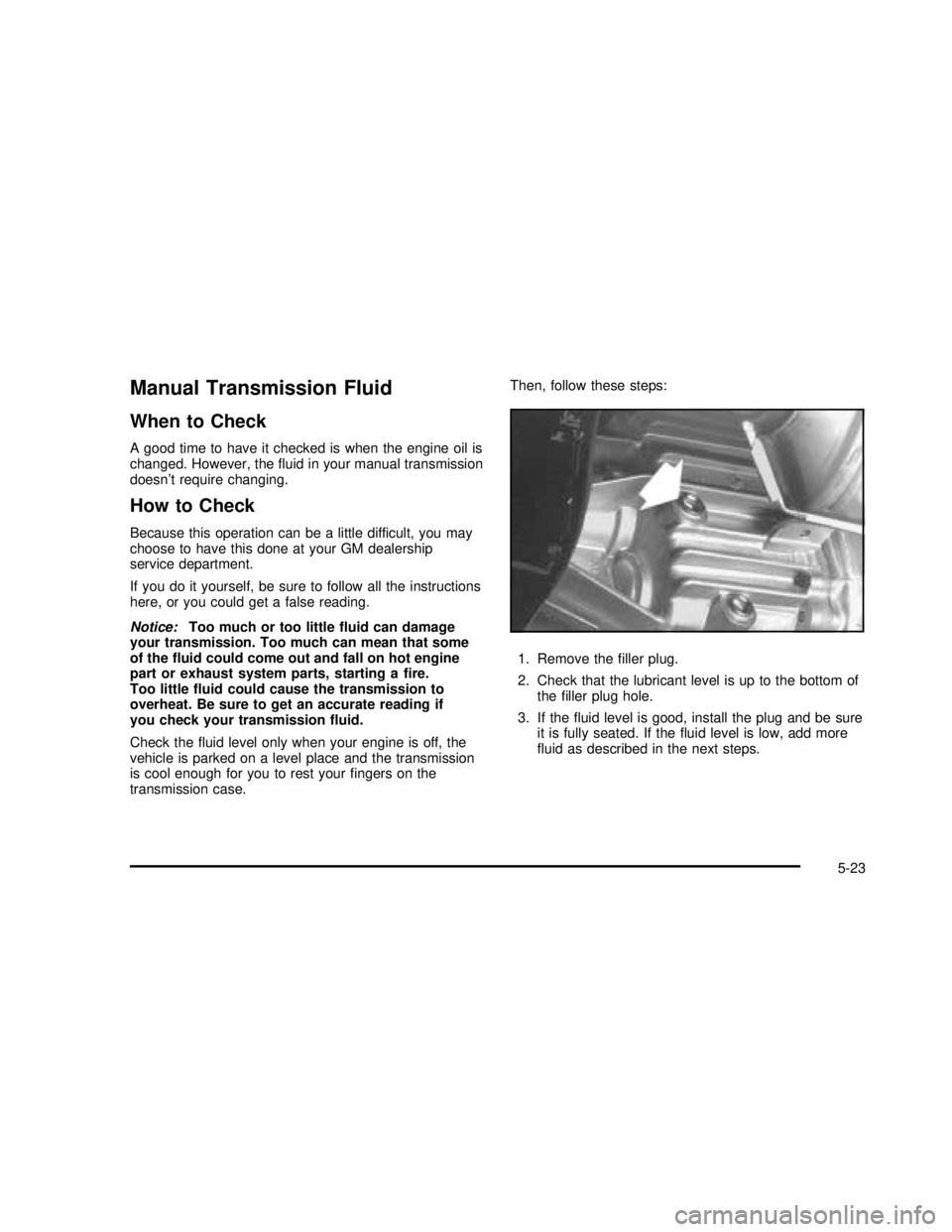
Manual Transmission Fluid
When to Check
A good time to have it checked is when the engine oil is
changed. However, the’¼éuid in your manual transmission
doesnŌĆÖt require changing.
How to Check
Because this operation can be a little difficult, you may
choose to have this done at your GM dealership
service department.
If you do it yourself, be sure to follow all the instructions
here, or you could get a false reading.
Notice:Too much or too little�uid can damage
your transmission. Too much can mean that some
of the�uid could come out and fall on hot engine
part or exhaust system parts, starting a�re.
Too little�uid could cause the transmission to
overheat. Be sure to get an accurate reading if
you check your transmission�uid.
Check the’¼éuid level only when your engine is off, the
vehicle is parked on a level place and the transmission
is cool enough for you to rest your’¼üngers on the
transmission case.Then, follow these steps:
1. Remove the’¼üller plug.
2. Check that the lubricant level is up to the bottom of
the’¼üller plug hole.
3. If the’¼éuid level is good, install the plug and be sure
it is fully seated. If the’¼éuid level is low, add more
’¼éuid as described in the next steps.
5-23
2003 - Sonoma OM
Page 282 of 424

How to Add Fluid
HereŌĆÖs how to add’¼éuid. Refer to the Maintenance
Schedule to determine what kind of’¼éuid to use.
SeePart D: Recommended Fluids and Lubricants on
page 6-33.
1. Remove the’¼üller plug.
2. Add’¼éuid at the’¼üller plug hole. Add only enough
’¼éuid to bring the’¼éuid level up to the bottom of the
’¼üller plug hole.
3. Install the’¼üller plug. Be sure the plug is fully
seated.
Hydraulic Clutch
The hydraulic clutch linkage in your vehicle is
self-adjusting. The clutch master cylinder reservoir is
’¼ülled with hydraulic clutch’¼éuid.
It is not necessary to regularly check clutch’¼éuid unless
you suspect there is a leak in the system. Adding
’¼éuid wonŌĆÖt correct a leak.
A’¼éuid loss in this system could indicate a problem.
Have the system inspected and repaired.
When to Check and What to Use
Refer to the Maintenance Schedule to determine how
often you should check the’¼éuid level in your clutch
master cylinder reservoir and for the proper’¼éuid.
SeePart B: Owner Checks and Services on page 6-26
andPart D: Recommended Fluids and Lubricants
on page 6-33.
5-24
2003 - Sonoma OM
Page 283 of 424

How to Check and Add Fluid
The proper’¼éuid should be added if the level does not
reach the bottom of the diaphragm when itŌĆÖs in place
in the reservoir. See the instructions on the
reservoir cap.
Engine Coolant
The cooling system in your vehicle is’¼ülled with
DEX-COOL®engine coolant. This coolant is designed
to remain in your vehicle for 5 years or 150,000 miles
(240 000 km), whichever occurs’¼ürst, if you add
only DEX-COOL
®extended life coolant.
The following explains your cooling system and how to
add coolant when it is low. If you have a problem
with engine overheating, seeEngine Overheating
on page 5-28.A 50/50 mixture of clean, drinkable water and
DEX-COOL
®coolant will:
ŌĆóGive freezing protection down toŌłÆ34┬░F(ŌłÆ37┬░C).
ŌĆóGive boiling protection up to 265┬░F (129┬░C).
ŌĆóProtect against rust and corrosion.
ŌĆóHelp keep the proper engine temperature.
ŌĆóLet the warning lights and gages work as
they should.
Notice:When adding coolant, it is important that
you use only DEX-COOL
®(silicate-free) coolant.
If coolant other than DEX-COOL®is added to
the system, premature engine, heater core or
radiator corrosion may result. In addition, the engine
coolant will require change sooner -- at 30,000 miles
(50,000 km) or 24 months, whichever occurs�rst.
Damage caused by the use of coolant other
than DEX-COOL
®is not covered by your new
vehicle warranty.
5-25
2003 - Sonoma OM
Page 284 of 424

What to Use
Use a mixture of one-halfclean, drinkable waterand
one-half DEX-COOL┬«coolant which wonŌĆÖt damage
aluminum parts. If you use this coolant mixture,
you donŌĆÖt need to add anything else.
{CAUTION:
Adding only plain water to your cooling
system can be dangerous. Plain water, or
some other liquid such as alcohol, can boil
before the proper coolant mixture will. Your
vehicleŌĆÖs coolant warning system is set for the
proper coolant mixture. With plain water or the
wrong mixture, your engine could get too hot
but you wouldnŌĆÖt get the overheat warning.
Your engine could catch�re and you or others
could be burned. Use a 50/50 mixture of clean,
drinkable water and the proper coolant.
Notice:If you use an improper coolant mixture, your
engine could overheat and be badly damaged. The
repair cost wouldnŌĆÖt be covered by your warranty.
Too much water in the mixture can freeze and crack
the engine, radiator, heater core and other parts.If you have to add coolant more than four times a year,
have your dealer check your cooling system.
Notice:If you use the proper coolant, you donŌĆÖt
have to add extra inhibitors or additives which claim
to improve the system. These can be harmful.
Checking Coolant
The coolant recovery tank is located in the engine
compartment near the passenger side of the vehicle.
SeeEngine Compartment Overview on page 5-10
for more information on location.
5-26
2003 - Sonoma OM
Page 285 of 424
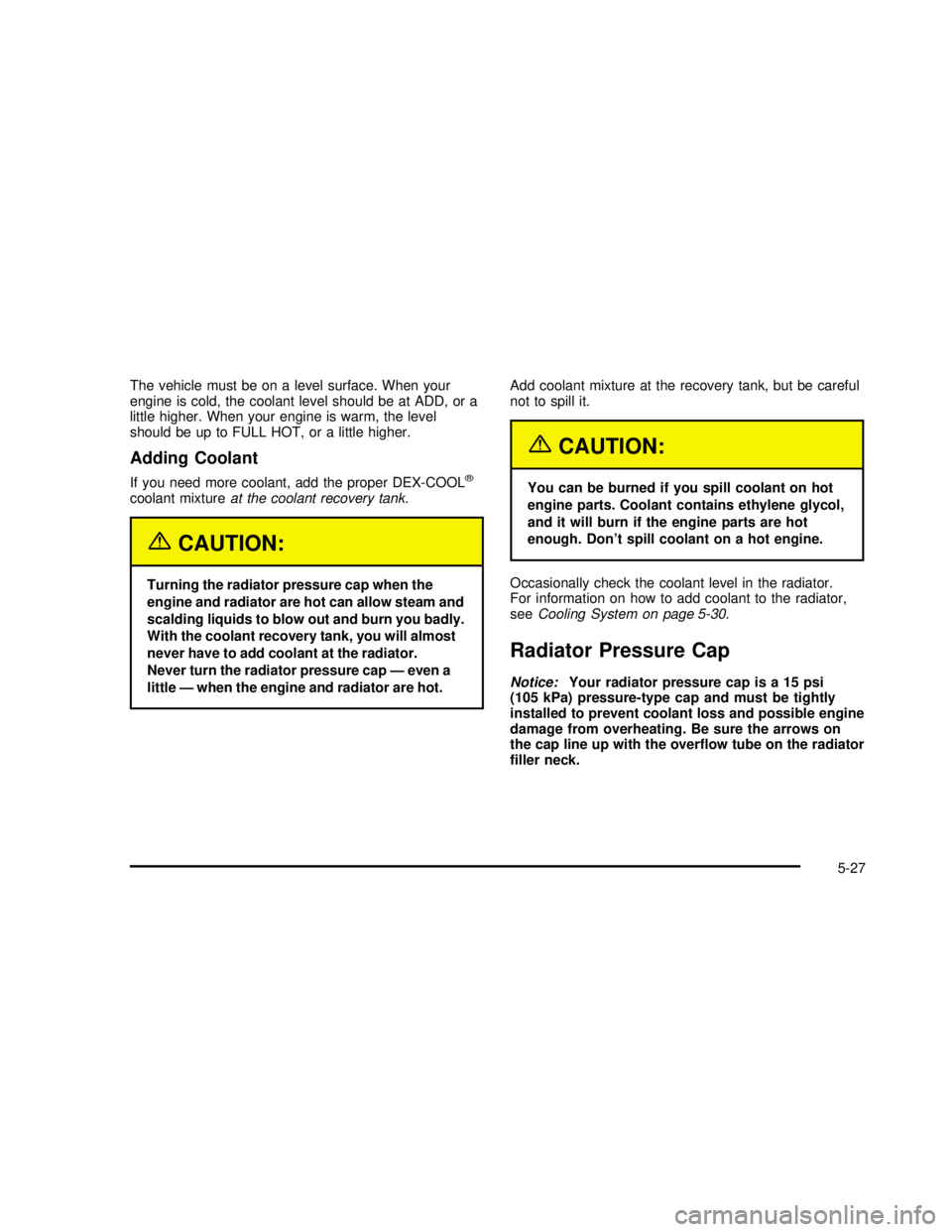
The vehicle must be on a level surface. When your
engine is cold, the coolant level should be at ADD, or a
little higher. When your engine is warm, the level
should be up to FULL HOT, or a little higher.
Adding Coolant
If you need more coolant, add the proper DEX-COOL®
coolant mixtureat the coolant recovery tank.
{CAUTION:
Turning the radiator pressure cap when the
engine and radiator are hot can allow steam and
scalding liquids to blow out and burn you badly.
With the coolant recovery tank, you will almost
never have to add coolant at the radiator.
Never turn the radiator pressure capŌĆöeven a
littleŌĆöwhen the engine and radiator are hot.Add coolant mixture at the recovery tank, but be careful
not to spill it.
{CAUTION:
You can be burned if you spill coolant on hot
engine parts. Coolant contains ethylene glycol,
and it will burn if the engine parts are hot
enough. DonŌĆÖt spill coolant on a hot engine.
Occasionally check the coolant level in the radiator.
For information on how to add coolant to the radiator,
seeCooling System on page 5-30.
Radiator Pressure Cap
Notice:Your radiator pressure cap is a 15 psi
(105 kPa) pressure-type cap and must be tightly
installed to prevent coolant loss and possible engine
damage from overheating. Be sure the arrows on
the cap line up with the over�ow tube on the radiator
�ller neck.
5-27
2003 - Sonoma OM
Page 286 of 424
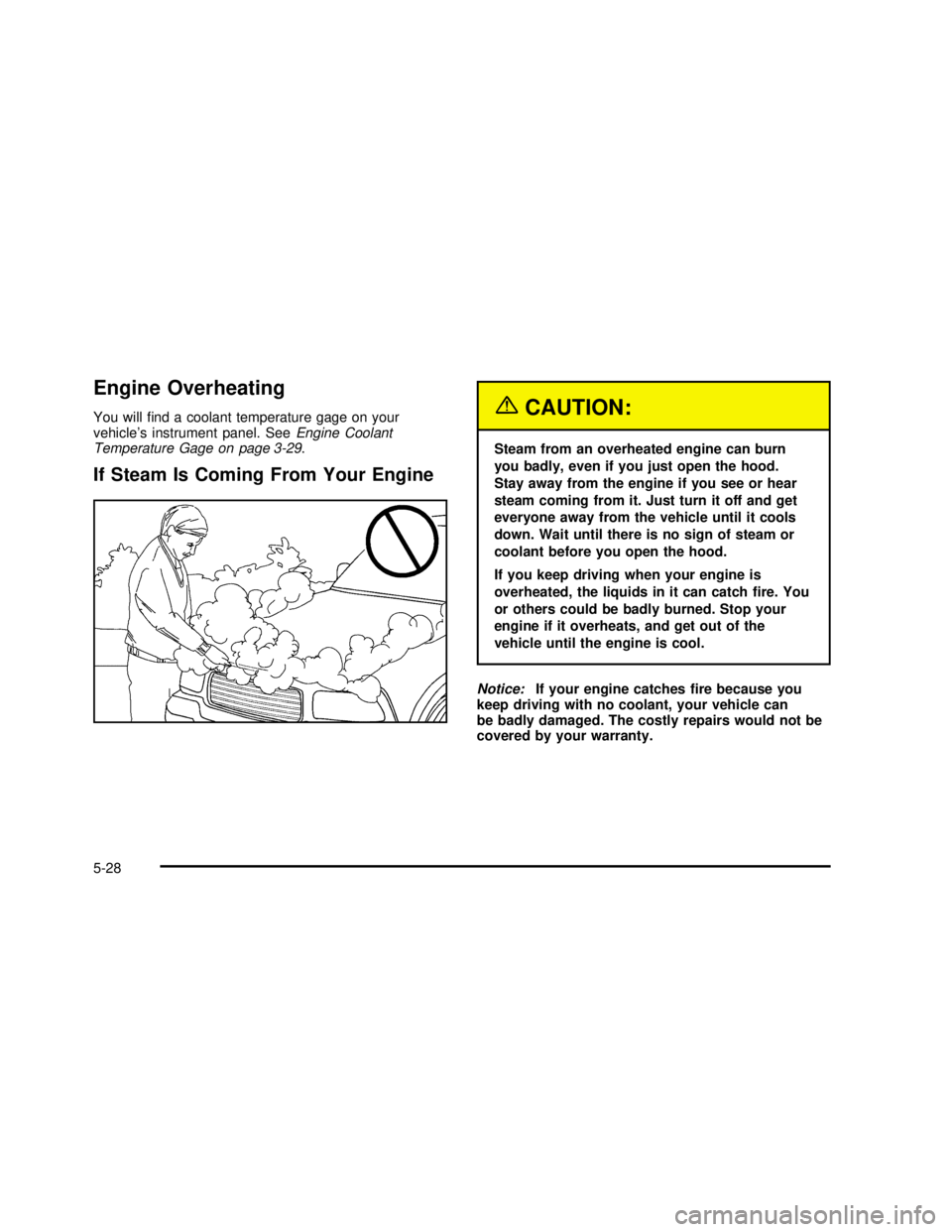
Engine Overheating
You will’¼ünd a coolant temperature gage on your
vehicleŌĆÖs instrument panel. SeeEngine Coolant
Temperature Gage on page 3-29.
If Steam Is Coming From Your Engine
{CAUTION:
Steam from an overheated engine can burn
you badly, even if you just open the hood.
Stay away from the engine if you see or hear
steam coming from it. Just turn it off and get
everyone away from the vehicle until it cools
down. Wait until there is no sign of steam or
coolant before you open the hood.
If you keep driving when your engine is
overheated, the liquids in it can catch�re. You
or others could be badly burned. Stop your
engine if it overheats, and get out of the
vehicle until the engine is cool.
Notice:If your engine catches�re because you
keep driving with no coolant, your vehicle can
be badly damaged. The costly repairs would not be
covered by your warranty.
5-28
2003 - Sonoma OM
Page 287 of 424

If No Steam Is Coming From Your
Engine
If you get an engine overheat warning but see or hear
no steam, the problem may not be too serious.
Sometimes the engine can get a little too hot when you:
ŌĆóClimb a long hill on a hot day.
ŌĆóStop after high-speed driving.
ŌĆóIdle for long periods in traffic.
ŌĆóTow a trailer. SeeŌĆ£Driving on GradesŌĆØunder
Towing a Trailer on page 4-51.
If you get the overheat warning with no sign of steam,
try this for a minute or so:
1. In heavy traffic, let the engine idle in NEUTRAL
while stopped. If it is safe to do so, pull off the
road, shift to PARK (P) or NEUTRAL and let the
engine idle.
2. Turn on your heater to full hot at the highest fan
speed and open the window as necessary.If you no longer have the overheat warning, you can
drive. Just to be safe, drive slower for about 10 minutes.
If the warning doesnŌĆÖt come back on, you can drive
normally.
If the warning continues, pull over, stop, and park your
vehicle right away.
If thereŌĆÖs still no sign of steam, idle the engine for three
minutes while youŌĆÖre parked. Push down the accelerator
until the engine speed is about twice as fast as normal
idle speed for at least three minutes while youŌĆÖre parked.
If you still have the warning,turn off the engine and get
everyone out of the vehicleuntil it cools down.
You may decide not to lift the hood but to get service
help right away.
5-29
2003 - Sonoma OM
Page 288 of 424
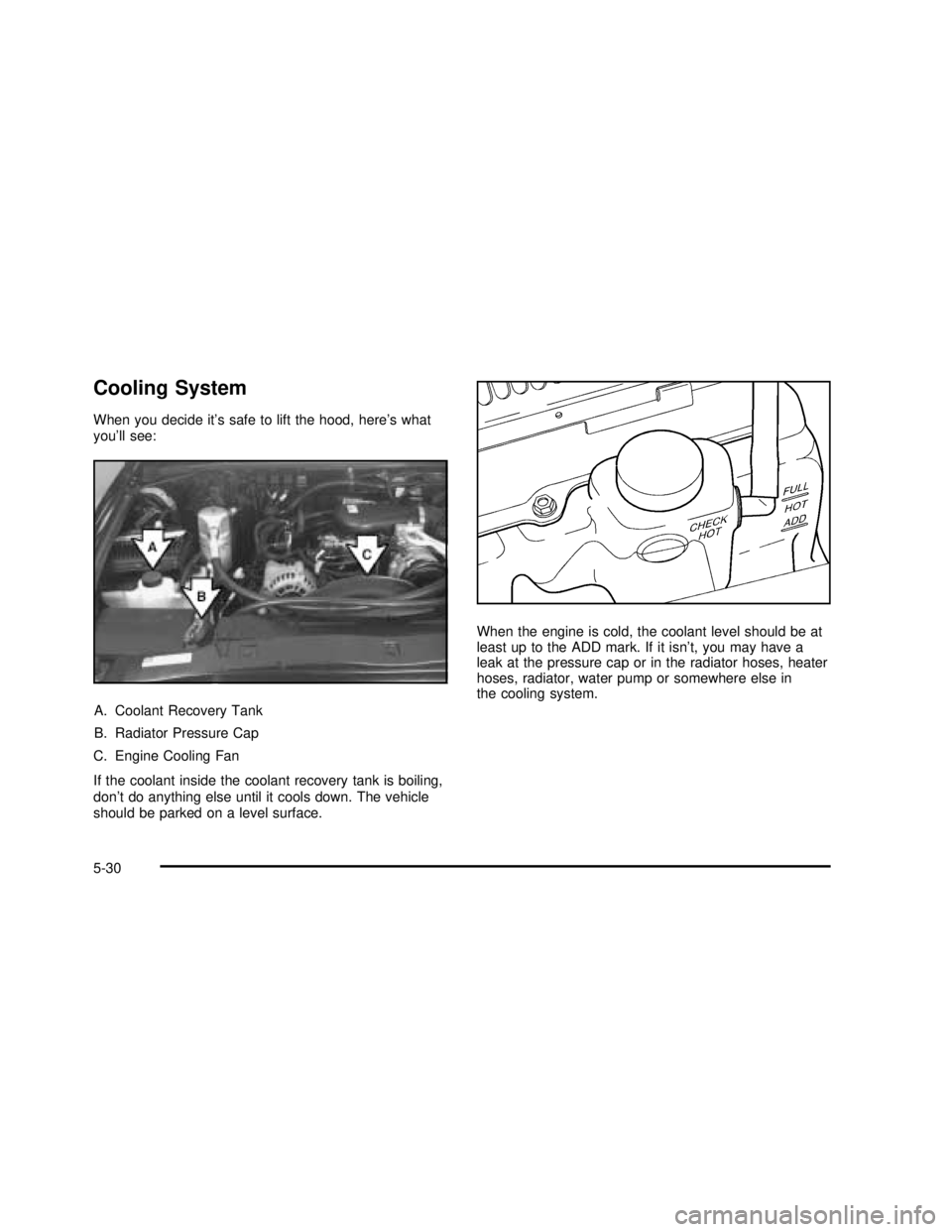
Cooling System
When you decide itŌĆÖs safe to lift the hood, hereŌĆÖs what
youŌĆÖll see:
A. Coolant Recovery Tank
B. Radiator Pressure Cap
C. Engine Cooling Fan
If the coolant inside the coolant recovery tank is boiling,
donŌĆÖt do anything else until it cools down. The vehicle
should be parked on a level surface.When the engine is cold, the coolant level should be at
least up to the ADD mark. If it isnŌĆÖt, you may have a
leak at the pressure cap or in the radiator hoses, heater
hoses, radiator, water pump or somewhere else in
the cooling system.
5-30
2003 - Sonoma OM
Page 289 of 424
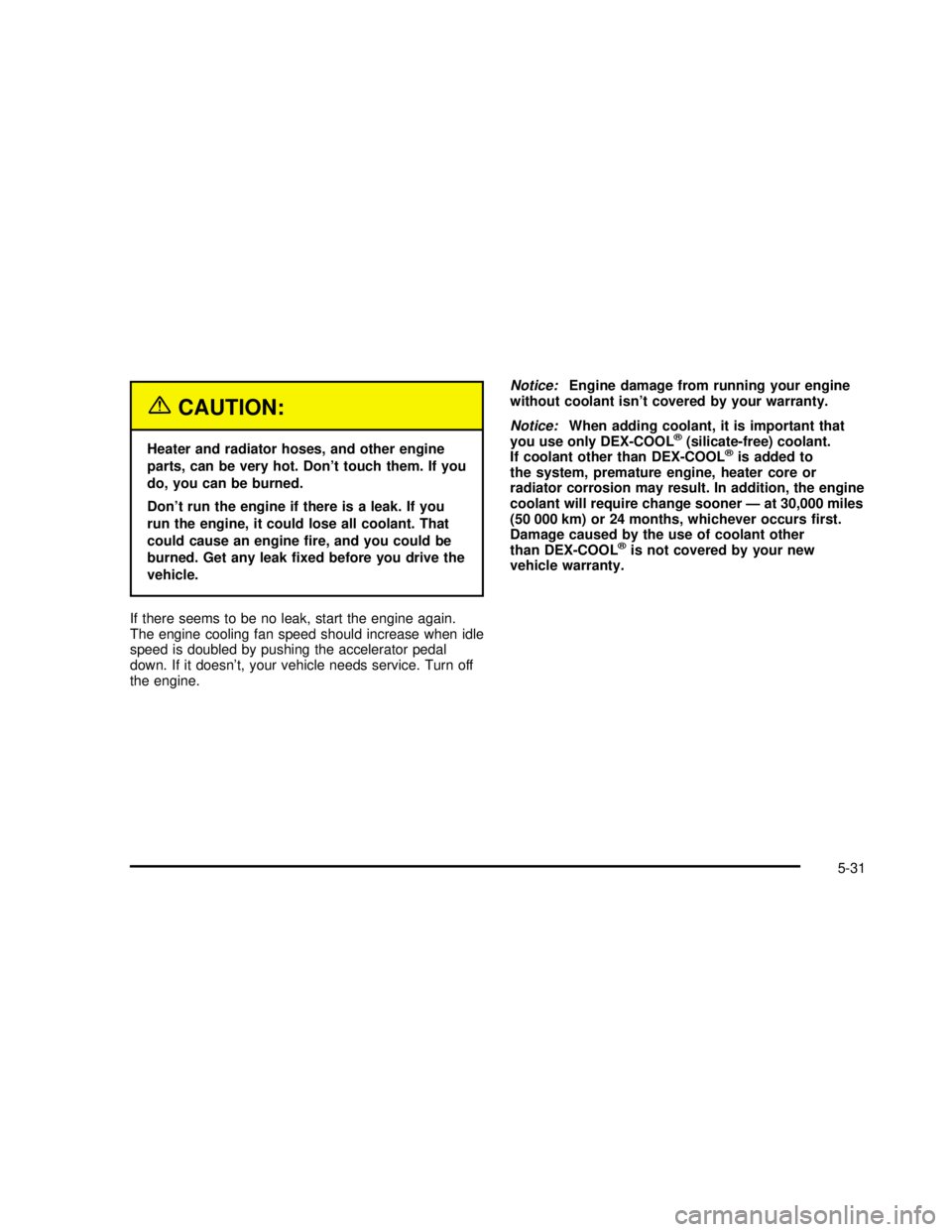
{CAUTION:
Heater and radiator hoses, and other engine
parts, can be very hot. DonŌĆÖt touch them. If you
do, you can be burned.
DonŌĆÖt run the engine if there is a leak. If you
run the engine, it could lose all coolant. That
could cause an engine�re, and you could be
burned. Get any leak�xed before you drive the
vehicle.
If there seems to be no leak, start the engine again.
The engine cooling fan speed should increase when idle
speed is doubled by pushing the accelerator pedal
down. If it doesnŌĆÖt, your vehicle needs service. Turn off
the engine.Notice:Engine damage from running your engine
without coolant isnŌĆÖt covered by your warranty.
Notice:When adding coolant, it is important that
you use only DEX-COOL®(silicate-free) coolant.
If coolant other than DEX-COOL®is added to
the system, premature engine, heater core or
radiator corrosion may result. In addition, the engine
coolant will require change soonerŌĆöat 30,000 miles
(50 000 km) or 24 months, whichever occurs�rst.
Damage caused by the use of coolant other
than DEX-COOL
®is not covered by your new
vehicle warranty.
5-31
2003 - Sonoma OM
Page 290 of 424
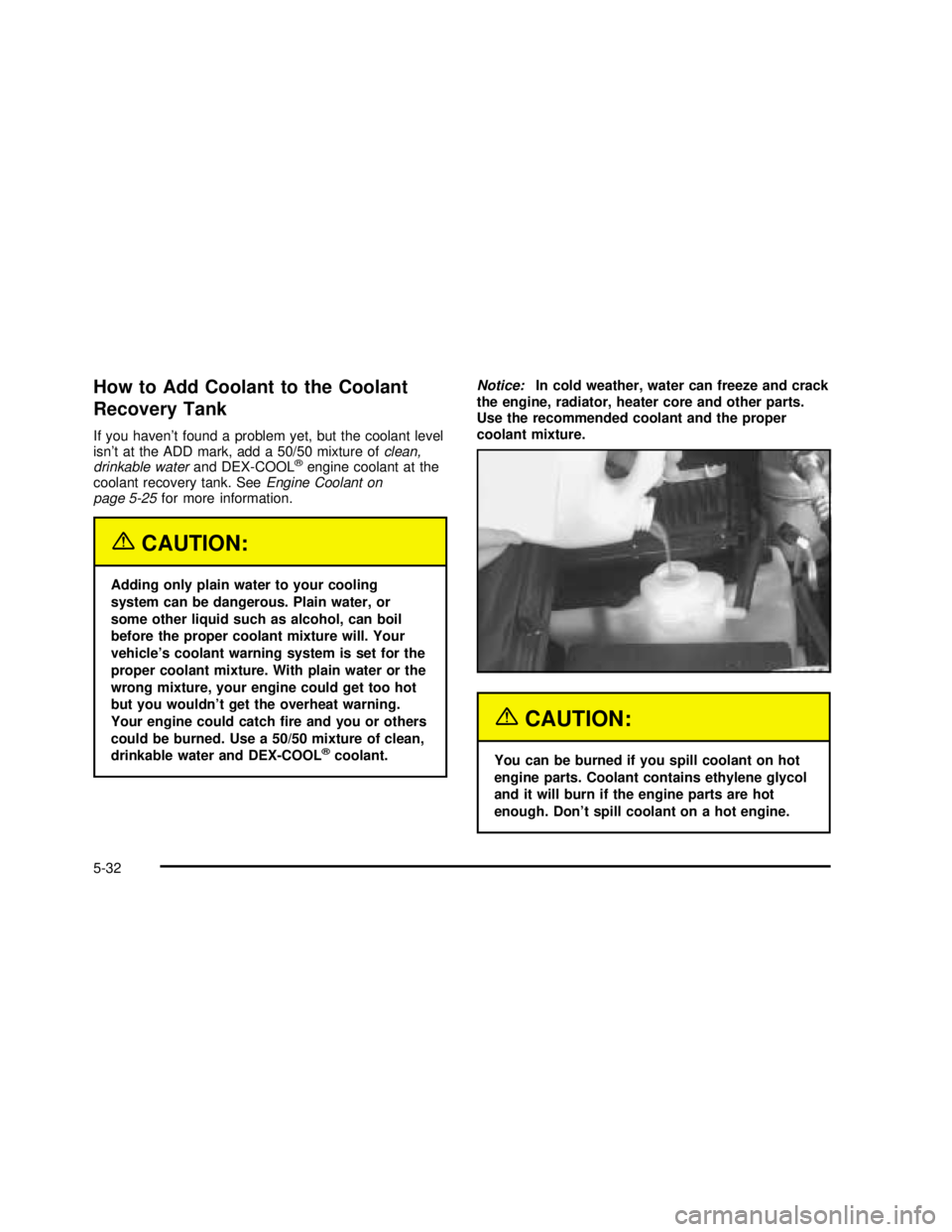
How to Add Coolant to the Coolant
Recovery Tank
If you havenŌĆÖt found a problem yet, but the coolant level
isnŌĆÖt at the ADD mark, add a 50/50 mixture ofclean,
drinkable waterand DEX-COOL
®engine coolant at the
coolant recovery tank. SeeEngine Coolant on
page 5-25for more information.
{CAUTION:
Adding only plain water to your cooling
system can be dangerous. Plain water, or
some other liquid such as alcohol, can boil
before the proper coolant mixture will. Your
vehicleŌĆÖs coolant warning system is set for the
proper coolant mixture. With plain water or the
wrong mixture, your engine could get too hot
but you wouldnŌĆÖt get the overheat warning.
Your engine could catch�re and you or others
could be burned. Use a 50/50 mixture of clean,
drinkable water and DEX-COOL
®coolant.Notice:In cold weather, water can freeze and crack
the engine, radiator, heater core and other parts.
Use the recommended coolant and the proper
coolant mixture.
{CAUTION:
You can be burned if you spill coolant on hot
engine parts. Coolant contains ethylene glycol
and it will burn if the engine parts are hot
enough. DonŌĆÖt spill coolant on a hot engine.
5-32
2003 - Sonoma OM